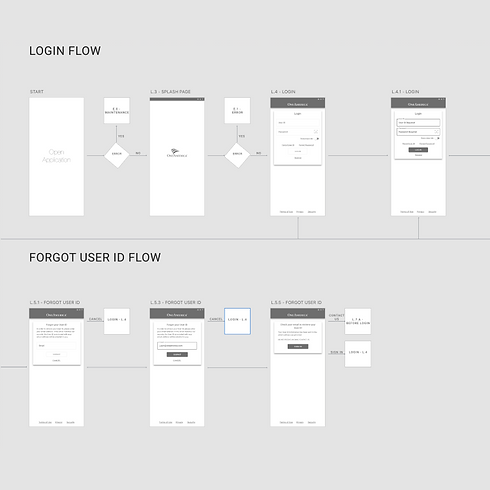
OneAmerica Case Study
Designing OA's First Mobile Application

Overview
OneAmerica is one of the fastest-growing mutual insurance holding companies in the U.S., providing financial services in retirement, life insurance, and employee benefits. Despite its long-standing reputation, OneAmerica lacked a mobile presence for its Retirement Services customers. My mission: design their first-ever mobile application, shaping a product that would empower users to view and manage their retirement investments on the go.
Problem Statement
Unlike its competitors, OneAmerica had no mobile app available to Retirement Services users. Customers had to rely on outdated, multi-step web portals to manage funds, limiting access and reducing engagement. The company needed a modern, intuitive mobile solution that would streamline user interactions while meeting compliance and accessibility standards.


Users & Audience
Primary users were current Retirement Services account holders, including:
-
Employees managing their 401(k) and retirement accounts
-
Financially curious users looking to make better-informed investment decisions
-
Plan sponsors needing access to real-time data and asset allocation tools
Project Goals
Launch OneAmerica’s first mobile MVP for public use
Reduce customer friction during key transactional flows
Simplify account visibility and asset management
Ensure ADA compliance and stakeholder alignment
Educate users on long-term investment planning
My Responsibilities
As the only UX Designer on the project (supported by a UX Director), I worked cross-functionally with developers, a UI designer, a project manager, and external vendors (Infosys, DXC) to lead all UX research and design efforts:
-
Conducted market research and competitive analysis
-
Created user journeys and mapped out wireflows
-
Designed low-fidelity and high-fidelity prototypes
-
Facilitated usability testing and gathered feedback
-
Delivered annotated designs and ADA-compliant prototypes
-
Participated in sprint planning and design reviews within Agile ceremonies
UX Process
Results & Impact
-
Successfully launched OneAmerica’s first mobile app MVP
-
Improved customer satisfaction scores through simplified navigation
-
Reduced average user task completion time by over 40%
-
Elevated brand competitiveness in the mobile fintech space
Key Takeaways
• Solo UX doesn’t mean siloed UX – cross-functional collaboration was critical
• Designing in a regulated financial environment required careful legal coordination
• Early testing saved time and minimized revisions
Prototyping And User Flows

Sometimes low fidelity can be mistaken for the final product.
I was able to complete and contribute to journey mapping, user flows, low fidelity designs and high fidelity prototyping. The breakdown to this was to:
-
Create User flows and wire-flows for interactive pieces and mapping out all possible paths. Wire-flows were used to give a visual aid on different paths of the application.
-
Create Low Fidelity Prototypes for quick design reviews. This is a great way to kick out screens and even functionality for the team.
-
Create Interactive High Fidelity Prototypes. This would help finalize designs and even be utilized for iterating through user testing for improvement of screens.
-
Lead and Validate ADA compliance was implemented while designing and developing the application. This included ADA Validation and Providing ADA annotations for vendors.
-
Utilize user testing for improving design and improving user experience make the app user friendly as well as intuitive. Testing screens and even testing flows.
-
Go through sprint planning to see what work will be done as well as meet with BA and UI Designer to walk through processes.
Sample Gallery of Low Fidelity
I wanted to share a few screenshots with you on some of the designs that were in the works.







